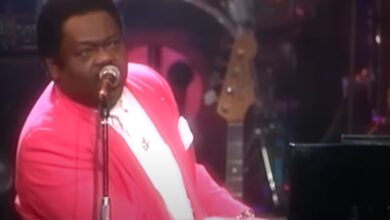Dwight Yoakam Delivered a Soulful Rendition of “I Sang Dixie”
In the annals of country music, few songs resonate with the poignant storytelling and emotional depth of Dwight Yoakam’s “I Sang Dixie.” Released in October 1988 as the second single from his album *Buenas Noches from a Lonely Room*, this track not only showcased Yoakam’s songwriting prowess but also cemented his place in the pantheon of country greats.
The narrative of “I Sang Dixie” is both haunting and evocative. The song’s narrator describes encountering a man from the Southern United States dying on a street in Los Angeles. As the narrator cradles the dying man, he sings ‘Dixie’ to comfort him in his final moments. The dying man warns the narrator to “run back home to that southern land” to escape “what life here has done to me.” This tale of displacement, regret, and the search for solace struck a chord with many listeners.
Dwight Yoakam’s journey to this poignant ballad began years earlier. Born in Pikeville, Kentucky, in 1956, Yoakam was steeped in the rich traditions of country music from a young age. However, his path to stardom was unconventional. In the early 1980s, Nashville’s music scene was dominated by the polished sounds of the “Urban Cowboy” movement, leaving little room for Yoakam’s brand of honky-tonk revivalism. Undeterred, he relocated to Los Angeles, immersing himself in the city’s vibrant “cowpunk” scene, where he shared stages with bands like The Blasters and Los Lobos.
This West Coast environment proved fertile for Yoakam’s artistry. His debut album, *Guitars, Cadillacs, Etc., Etc.*, released in 1986, was a breath of fresh air, blending traditional country with rock and punk influences. The album’s success paved the way for subsequent releases, each showcasing Yoakam’s distinctive voice and storytelling abilities.
By the time “I Sang Dixie” was released, Yoakam had already made a significant impact on the country music scene. The song’s ascent to the number one spot on the Billboard Hot Country Songs chart in 1989 was a testament to its emotional resonance and Yoakam’s growing popularity. Its success was further underscored when Rolling Stone ranked “I Sang Dixie” No. 26 on its list of the 40 Saddest Country Songs of All Time in 2019.
The song’s success was not just a personal milestone for Yoakam but also a reflection of a broader movement within country music. In the late 1980s, there was a resurgence of interest in traditional country sounds, a movement often referred to as the “New Traditionalist” wave. Artists like Yoakam, along with Randy Travis and George Strait, led this charge, bringing honky-tonk and Bakersfield influences back into the mainstream.
“I Sang Dixie” also highlighted Yoakam’s ability to craft songs that were both deeply personal and universally relatable. The themes of displacement and longing resonated with many, especially those who had experienced the challenges of leaving home in search of better opportunities, only to find themselves yearning for their roots.
The song’s production, under the guidance of Yoakam’s longtime collaborator Pete Anderson, was both sparse and evocative, allowing the narrative to take center stage. Anderson’s guitar work complemented Yoakam’s vocals perfectly, creating a soundscape that was both timeless and contemporary.
In the years following its release, “I Sang Dixie” has remained a staple in Yoakam’s live performances. Its enduring popularity is a testament to its timeless appeal and the emotional depth of its storytelling.
Beyond its commercial success, the song has had a lasting influence on the genre. It has been covered by various artists and continues to be celebrated as one of Yoakam’s signature songs. Its themes of loss, regret, and the search for solace remain relevant, resonating with new generations of listeners.
Reflecting on his career, Yoakam has often cited “I Sang Dixie” as one of his most personal and meaningful songs. In interviews, he has spoken about the inspiration behind the song and its significance in his body of work.
As of 2025, Dwight Yoakam’s influence on country music remains profound. His blend of traditional and contemporary sounds has inspired countless artists, and songs like “I Sang Dixie” continue to be celebrated for their storytelling and emotional depth.
In conclusion, “I Sang Dixie” stands as a testament to Dwight Yoakam’s artistry and his ability to craft songs that resonate deeply with listeners. Its enduring popularity and impact on the country music landscape underscore its significance as one of the genre’s most poignant ballads.



